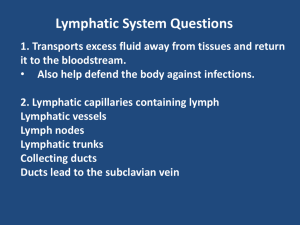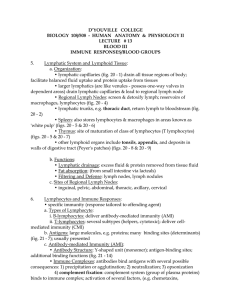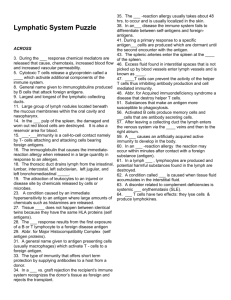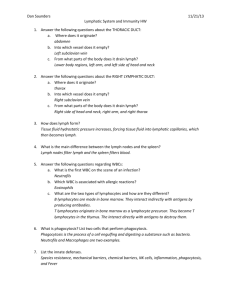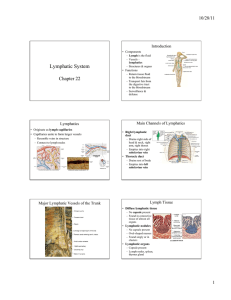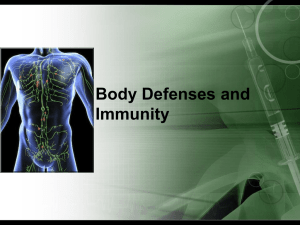Lymphatic System
advertisement
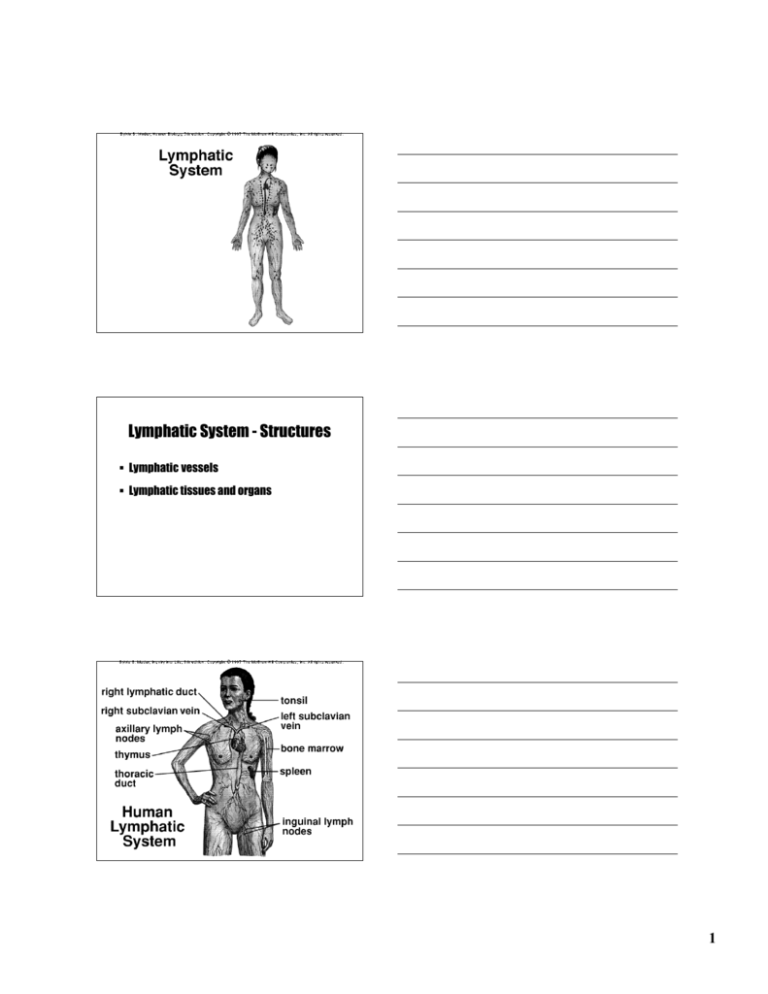
Lymphatic System - Structures Lymphatic vessels Lymphatic tissues and organs 1 Lymphatic System - Functions Returns leaked plasma to blood vessels Cleanses lymph of bacteria & other foreign matter Provides site for surveillance by cells of immune system Lymphatic Vessels Structure Thin-walled, permeable vessels Valves prevent backflow Contain lymph Functions Picks up excess tissue fluid, returns it to bloodstream 2 Composition of Lymph Mostly water Small amounts of dissolved protein 3 Lymphoid Organs Lymph node Spleen Thymus Tonsils Peyer’s patches Body Defenses Nonspecific defense system Intact skin & mucus membranes Inflammatory response Proteins produced by body cells Specific defense system - immune system Antibody-mediated immunity Cell-mediated immunity 4 Surface Membrane Barriers Body’s first line of defense Structures Skin & mucus membranes Functions Acid pH of skin & vaginal secretions - antibacterial HCL secreted by stomach Salvia & tears - antibacterial enzyme Sticky mucus in digestive & respiratory tracts Nonspecific Defense - Cells Phagocytes Neutrophils and macrophages Phagocytosis Natural killer cells Attack and kill cancer cells and virus-infected body cells Lysis Inflammatory Response Body’s second line of defense Nonspecific response to injury Cardinal signs Redness Heat Swelling Pain 5 Antimicrobial Chemicals Complement Plasma proteins Lyses microorganisms Interferons Proteins released by virus-infected cells Protects uninfected cells from viral takeover 6 Fever Systemic response - increase body temperature Pyrogens released Increased body temperature inhibits bacterial growth Enhances body repair processes 7 Immune System Specific defense system Immune response Is antigen specific Is systemic Has “memory” Types of immunity Antibody-mediated or humoral immunity Cell-mediated immunity Antigens Any substance capable of exciting the immune system and provoking the immune response. Nonself All foreign protein, nucleic acids, many large carbohydrates, some lipids Pollen grains, microorganisms Cells of the Immune System Lymphocytes B lymphocytes T lymphocytes Immunocompetent Capable of responding to a specific antigen by binding to it. Macrophages Engulf foreign particles & present fragments of antigen on their surface. 8 Development of Lymphocytes Hemocytoblast - in red bone marrow Immature lymphocytes T cells migrate to and mature in thymus B cells remain and mature in bone marrow Immunocompetent Recognizes and binds to specific antigen Mature lymphocytes Humoral (Antibody-Mediated) Immune Response Primary humoral response Mature B cells - antigen binds to surface receptors Plasma cells > antibodies Memory cells 9 Antibodies Plasma proteins - immunoglobulins Made by B cells Structure “Y” shaped Antigen-binding site Classes IgM, IgA, IgD, IgG, IgE 10 Antibody Function Inactivates antigens by Neutralization Block dangerous parts of toxin or virus Agglutination Cross-linking cell-bound antigens causes clumping Precipitation Cross-linking soluble antigens > become insoluble Cellular (Cell-Mediated) Immune Response Macrophages engulf antigen Antigen presentation - macrophages processes antigen and displays processed antigen(nonself) plus self-protein on their surface T cells recognize non-self and self proteins T cell clones 11 Classes of T-Cell Clones Helper T cells Stimulate production of other immune cells Cytotoxic (killer) T cells Kills virus-invaded cells, cancer cells, graft rejection Memory T cells Generated during primary response, exist for years, respond quickly to second infection 12 Acquired Immunity Naturally acquired Active Infection; contact with disease-causing organism Passive Antibodies from mother to fetus via placenta; to infant from mother’s milk Artificially acquired Active Vaccine; dead or weakened pathogens Passive Injection of antibodies Organ Transplants and Rejection Allografts Tissue grafts taken from an unrelated person Tissue typing Blood types (ABO) Matching cell membrane antigens 75% match necessary 13 Disorders of Immunity Allergies or hypersensitivities Abnormally vigorous immune responses that causes tissue damage Immunodeficiencies AIDS Autoimmune diseases Multiple sclerosis, Systemic Lupus Erythematosus, Rheumatoid arthritis The End 14
